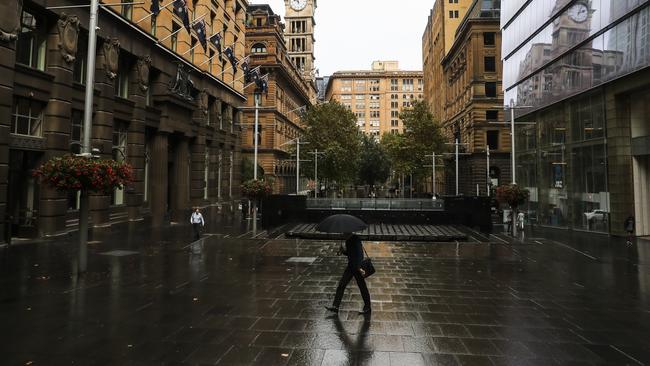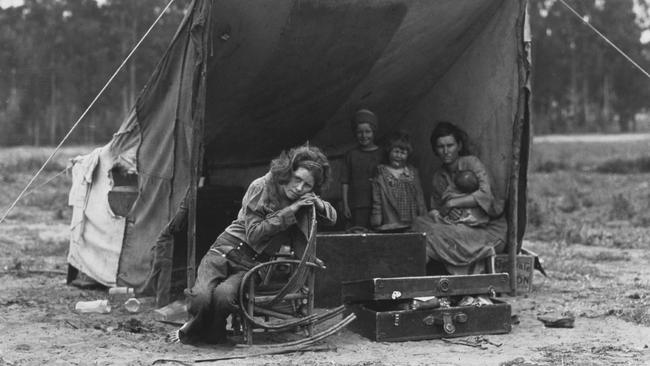Coronavirus prediction: Australian economic growth to be worst since Great Depression
Australia’s economic growth will slump 6pc in 2020, the nation’s sharpest GDP contraction since the 1930s, Goldman Sachs predicts.

Goldman Sachs predicts Australia’s economic growth in 2020 will be the worst since the Great Depression.
The US investment bank’s Australian chief economist, Andrew Boak, has forecast a 6 per cent fall real GDP in annual average terms this year after slashing his forecasts amid a “severe deterioration in the Australian economy over the past week as the COVID-19 outbreak has intensified”.
If Australia’s economic growth rate was to fall by more than a 5.1 per cent decline in 1945 – after World War II demobilisation – it would be the worst year of growth since a 9.6 per cent fall in 1930, the start of the Great Depression, which extended through the 1930s.
“Looking ahead, the global experience suggests social-distancing and broader containment measures will intensify further over the coming weeks and – with Australia entering its winter mid-year - the revised guidance from the government is to prepare for containment measures extending for ‘at least the next six months’,” Mr Boak said in a report to clients on Friday.
“Given this rapid deterioration in the outlook, we now estimate the Australian economy will contract 6 per cent in 2020 in annual average terms (average levels of GDP in all of 2020 compared to 2019).”
“This represents the sharpest annual GDP contraction since the Great Depression.”
Mr Boak says such a sharp fall in growth could push the unemployment rate up to about 8.5 per cent from a rate of 5.1 per cent recorded for February. However would not be anywhere near as bad as the Great Depression, when US unemployment hit a record high of around 30 per cent.

As opposed to a recession - defined by two consecutive quarters of negative economic growth and usually some rise in unemployment – a depression is characterised by a sustained, long-term fall in economic growth in one or more economies as well as unemployment levels above 10 per cent.
Mr Boak is also “somewhat cautious” about this estimate given some workers are likely to leave the labour market and many businesses will hold on to employees but drastically cut back hours.
These two factors should prevent a more substantial rise in the official unemployment rate.
Most of the contraction is expected to be driven by a collapse in “social” consumption as the government continues to enact increasingly-aggressive containment measures to manage the COVID-19 outbreak, banning “non-essential” indoor gatherings of over 100 people and 500 people in outdoor gatherings, and fully closing Australia’s borders.
The government has advised to prepare for containment measures for “at least the next six months.”
At the same time, the global macro backdrop has also continued to weaken and there has been a “clear loss of confidence in financial markets”, according to Mr Boak.
But in contrast to past recessions, measures taken to contain the virus will result in the contraction in growth being compressed almost entirely into a single quarter.
June quarter growth is expected to fall 10 per cent compared to the March quarter – marking the largest quarterly contraction in demand on record.
“While the exact magnitudes are very difficult to estimate, for the purposes of our forecasts we assume spending at hotels, cafes and restaurants to fall more than half, while spending on many discretionary categories to fall by up to one third,” Mr Boak says.
“As more people work from home, higher spending on food and utilities will provide a modest offset to growth, but investment activity and exports are also likely to contract.”
He acknowledges there is “considerable uncertainty around these forecasts” and “policymakers are taking increasingly aggressive action to mitigate the downside risks”.
“In our view, however, the measures announced by the RBA will do more to maintain the smooth functioning of financial/credit markets than deliver a sizeable positive stimulus to growth.
“Even when factoring in the fiscal package announced to date, we note the current impulse to GDP growth from the combined monetary and fiscal policies amounts to just over one percentage point in 2020,” Mr Boak says. “This is a very modest boost in the context of the growth headwind facing the Australian economy, and is only around one-fifth as large as that delivered during the GFC.”




To join the conversation, please log in. Don't have an account? Register
Join the conversation, you are commenting as Logout